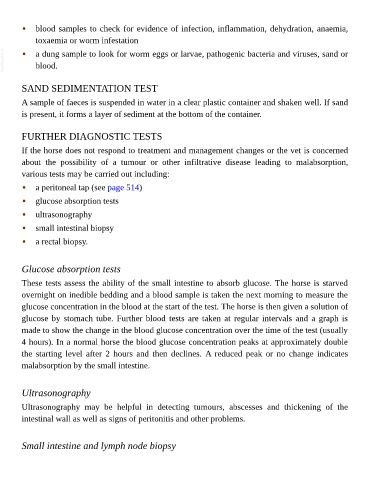Page 780 - The Veterinary Care of the Horse
P. 780
• blood samples to check for evidence of infection, inflammation, dehydration, anaemia,
toxaemia or worm infestation
VetBooks.ir • a dung sample to look for worm eggs or larvae, pathogenic bacteria and viruses, sand or
blood.
SAND SEDIMENTATION TEST
A sample of faeces is suspended in water in a clear plastic container and shaken well. If sand
is present, it forms a layer of sediment at the bottom of the container.
FURTHER DIAGNOSTIC TESTS
If the horse does not respond to treatment and management changes or the vet is concerned
about the possibility of a tumour or other infiltrative disease leading to malabsorption,
various tests may be carried out including:
• a peritoneal tap (see page 514)
• glucose absorption tests
• ultrasonography
• small intestinal biopsy
• a rectal biopsy.
Glucose absorption tests
These tests assess the ability of the small intestine to absorb glucose. The horse is starved
overnight on inedible bedding and a blood sample is taken the next morning to measure the
glucose concentration in the blood at the start of the test. The horse is then given a solution of
glucose by stomach tube. Further blood tests are taken at regular intervals and a graph is
made to show the change in the blood glucose concentration over the time of the test (usually
4 hours). In a normal horse the blood glucose concentration peaks at approximately double
the starting level after 2 hours and then declines. A reduced peak or no change indicates
malabsorption by the small intestine.
Ultrasonography
Ultrasonography may be helpful in detecting tumours, abscesses and thickening of the
intestinal wall as well as signs of peritonitis and other problems.
Small intestine and lymph node biopsy

